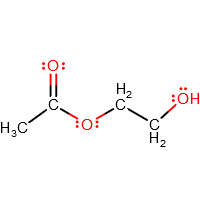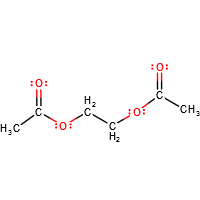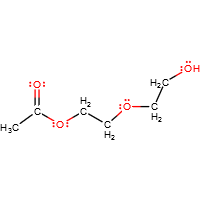Cou
National Hazard
   
Posts: 958
Registered: 16-5-2013
Member Is Offline
Mood: Mad Scientist
|
|
Thought from "Fisher esterificatioon of ethylene glycol"
WARNING: I am a noob at organic chemistry.
For this example, I will use acetic acid and ethylene glycol.
This is the ester that I predict would result from a fisher esterification with those 2 compounds:

However, that ethylene glycol remnant still has an alcohol group at the other end! This is what I predict you could do with that alcohol group:
1. Do another fisher esterification with acetic acid, making a 2-sided ester:

2. Dehydration of the ester with sulfuric acid and ethylene glycol to extend the alcohol chain:

Would these organic reactions actually take place?
[Edited on 3-11-2015 by Cou]
|
|
|
Oscilllator
National Hazard
   
Posts: 659
Registered: 8-10-2012
Location: The aqueous layer
Member Is Offline
Mood: No Mood
|
|
I too am a noob at organic chemistry but I'm pretty sure the "dehydration" stage wouldn't happen.
What you've actually written down there is the ketone group on the end there getting reduced and the methyl group on the end getting oxidised to an
alcohol. I don't really see how it's possible for both of these reactions to occur at once, but like I said I am a noob so I could well be wrong.
Perhaps one of the moderators would be so kind as to chip in as they move this to beginnnings? *cough Nicodem cough*
|
|
|
Ozone
International Hazard
    
Posts: 1269
Registered: 28-7-2005
Location: Good Olde USA
Member Is Offline
Mood: Integrated
|
|
That is a proper ester, RCOOR', not a ketone, RCOR'. I imagine with a trace of acid, you'd get mixed esters. With a 4x mole equivalent of conc.
sulfuric, you might get an ungodly gunge containing an equilibrium mixture of PEG-acetates, PEGs and tar. Push it harder, and you might also add
mixed olefins to the mix, as well. Then...carbon--this stuff won't be volatile like diethyl ether.
Most PEGs are made via polymerization of ethylene oxide (with an acid or base catalyst). The above is not a preferred route--I'd imagine because all
of the species in there limit the molecular weight (or carbonize). And...yield an intractable mixture of gunge.
O3
[Edited on 4-11-2015 by Ozone]
-Anyone who never made a mistake never tried anything new.
--Albert Einstein
|
|
|
Dr.Bob
International Hazard
    
Posts: 2658
Registered: 26-1-2011
Location: USA - NC
Member Is Offline
Mood: No Mood
|
|
If you mix 1 part ethylene glycol EG to one part acetic acid AA, and heated under acid, you will get a mixture of roughly 1/4 part EG, 1/4 part AA,
1/4 EG monoacetate, and 1/4 EG diacetate. When you have a difunctional molecule, the most common reaction with one part of another reactive is a
statistical mixture, although the exact mixture will depend on many variables (water contamination, amount of acid, temperature, etc).
Now if you reacted one part EG with more than 2 parts AA, under acid conditions, you might be able to drive the reaction closer to equilibrium, and
get predominantly the EG diacetate, but even then. it is hard to go to completion unless you drive the reaction to the product with some thermodynamic
force, like removal of the water formed somehow, or removal of a product by distillation. Most reactions are in equilibrium, and can only be driven
right or left by applying some energy to force the reaction to occur, either with more activated reagents (acetyl chloride and DMAP) or by removing
one of the products.
|
|
|
clearly_not_atara
International Hazard
    
Posts: 2693
Registered: 3-11-2013
Member Is Offline
Mood: Big
|
|
^Equilibrium isn't always 1:1 and generally depends on a variety of conditions (temperature, pressure, H+ concentration, possibility of forming
adducts, etc).
Dioxane is a major product of reaction of ethylene glycol with H2SO4 at warm temperatures, despite the potential for tar formation. This is because
its low molecular weight and high volatility make it entropically favorable. In this case, ethylene glycol diacetate plays the same role; dioxane is
removed from the reaction by volatility, ethylene glycol diacetate by its low affinity for water. Some diacetate is always produced when trying to
produce the monoacetate.
Formation of high MW products (tar) is thermodynamically disfavored at high temperature but is kinetically favorable when ethylene oxide is the
monomer. H2SO4 + ethylene glycol produces a small amount of ethylene oxide by elimination; this ethylene oxide goes on to produce the tars generally
seen in this reaction. Ethylene oxide can also react with ethylene glycol monoacetate to produce acetate-terminated tars.
But if you simply esterify ethylene glycol with AcOH and H2SO4, you should expect a mixture of products, dominated by the monoacetate, diacetate,
dioxane, and the reactants, but also including tars.
[Edited on 4-11-2015 by clearly_not_atara]
|
|
|
Cou
National Hazard
   
Posts: 958
Registered: 16-5-2013
Member Is Offline
Mood: Mad Scientist
|
|
Wow, I never knew how messy organic reactions are with ethylene glycol. I guess that explains why there is relatively little data for the products: If
sigma aldrich doesn't even sell EG monoacetate, that's saying something.
But it must be possible to separate the gunge of organic molecules with fractional distillation, right?
|
|
|
gdflp
Super Moderator
      
Posts: 1320
Registered: 14-2-2014
Location: NY, USA
Member Is Offline
Mood: Staring at code
|
|
The problem may be that, over time, the transesterification reaction 2AcOCH<sub>2</sub>CH<sub>2</sub>OH <-->
HOCH<sub>2</sub>CH<sub>2</sub>OH + AcOCH<sub>2</sub>CH<sub>2</sub>OAc reaches equilibrium and you no
longer have the pure monoester. That might be why Aldrich doesn't sell it.
|
|
|
DraconicAcid
International Hazard
    
Posts: 4278
Registered: 1-2-2013
Location: The tiniest college campus ever....
Member Is Offline
Mood: Semi-victorious.
|
|
If you use a large excess of acetic anhydride, you should have no trouble maximizing your yield of the diacetate.
Please remember: "Filtrate" is not a verb.
Write up your lab reports the way your instructor wants them, not the way your ex-instructor wants them.
|
|
|
karlos³
International Hazard
    
Posts: 1520
Registered: 10-1-2011
Location: yes!
Member Is Offline
Mood: oxazolidinic 8)
|
|
Ethylene glycol is as a dialcohol not without a reason part of the polyester PET.
I guess separation of the "gunk" won´t happen.
|
|
|
clearly_not_atara
International Hazard
    
Posts: 2693
Registered: 3-11-2013
Member Is Offline
Mood: Big
|
|
The monoacetate can be formed selectively by esterification of 2-chloroethanol or 2-bromoethanol with NaOAc.
The halohydrins can be formed most easily using ethylene, which is a highly flammable gas and thus its preparation, while easy, might not be good for
a beginner. The preferred method uses ethanol and H3PO4:
http://pubs.rsc.org/en/Content/ArticleLanding/1901/CT/ct9017...
Ethylene is passed through an aqueous solution of a halogenating agent such as TCCA, NaOCl, Br2, NCS/NBS, etc, giving 2-haloethanol. TCCA/NBS etc can
be better than hypochlorites or halogens because they are less likely to cause side-reactions (particularly oxidation).
| Quote: | | But it must be possible to separate the gunge of organic molecules with fractional distillation, right? |
Yields of the monoacetate will probably be low. Since there isn't much market for EG monoacetate they probably didn't think it was worth it.
[Edited on 6-11-2015 by clearly_not_atara]
|
|
|
karlos³
International Hazard
    
Posts: 1520
Registered: 10-1-2011
Location: yes!
Member Is Offline
Mood: oxazolidinic 8)
|
|
One should add that 2-haloethanols are very toxic.
|
|
|